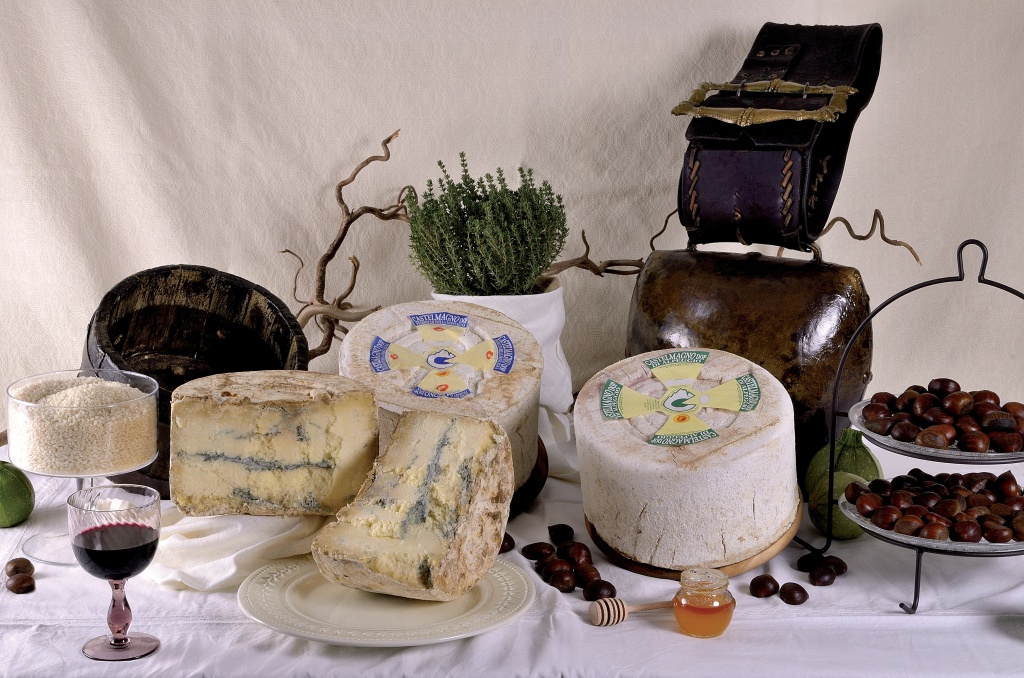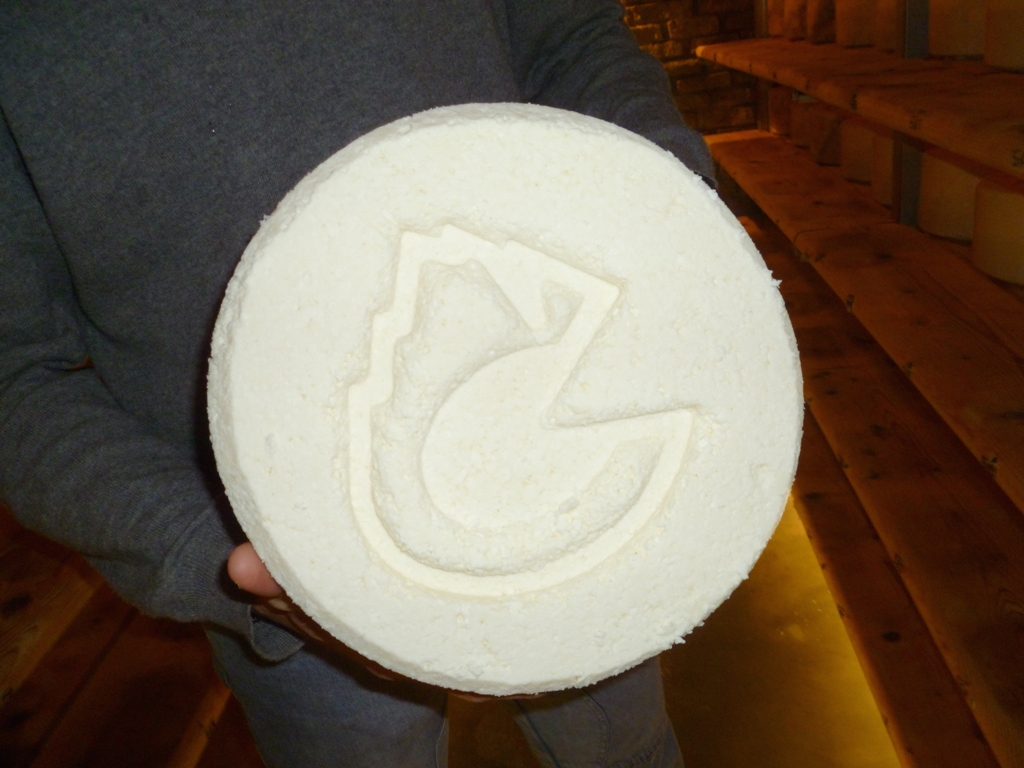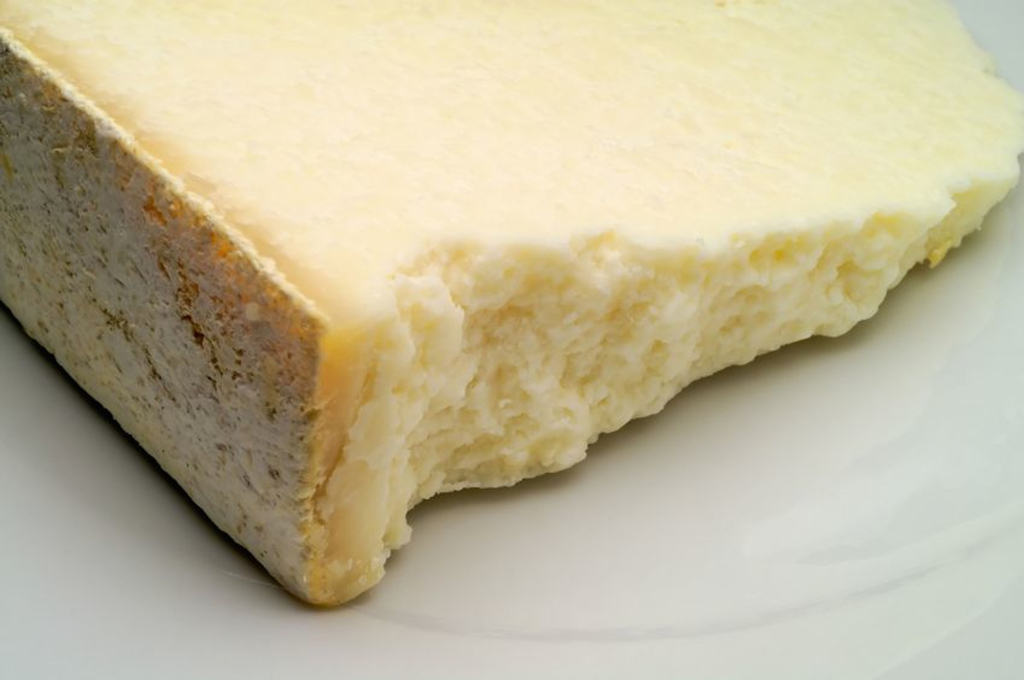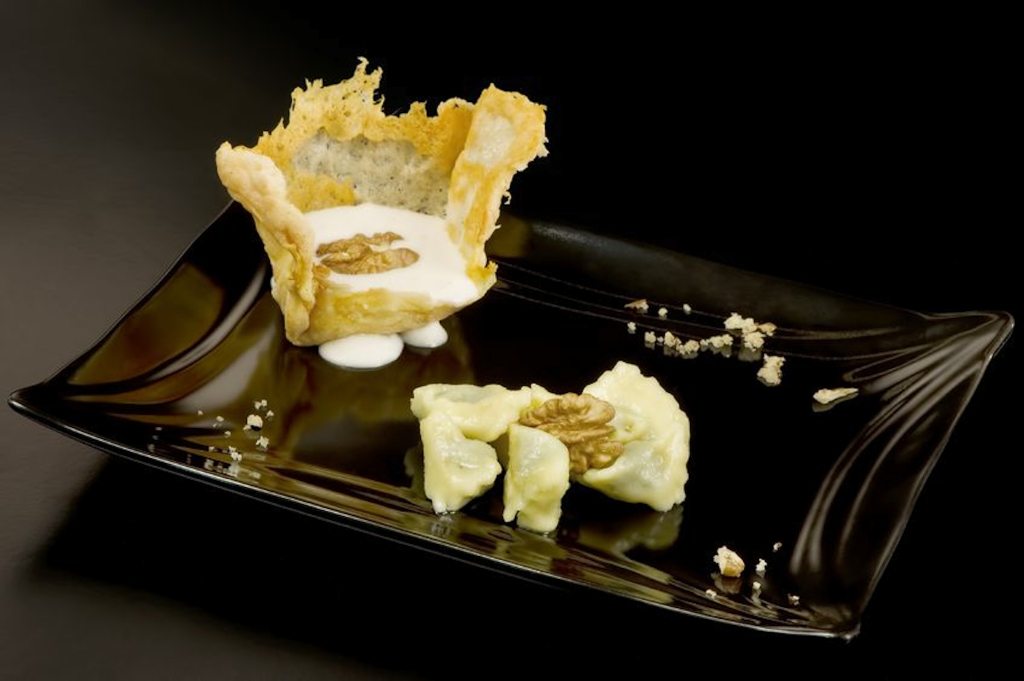 Despite its particular cylindrical and compact shape and its green stripes in green-dark blue colour, the Castelmagno cheese immediately stands out for its intense and distinctive scent. It is characterized by a pleasing aromatic bouquet, which reminds the pleasant acid of lactic fermentation, dry forage of mountain, and the moist and fresh room used for seasoning it. After satisfying sight and smell, the taste of Castelmagno does not result to be disappointing as for flavour, with its savoury taste, which becomes spicy and strong in the most mature cheeses. This happens thanks to the careful selection of raw cow's milk, with small additions of sheep’s and goat’s milk. The milk which is used for preparing the Castelmagno comes from the high natural value land in the province of Cuneo, which boasts ancient Occitan tradition, in the South-western Piedmont. The cattle which produce this milk are fed exclusively on fresh forage and hay produced in this area, which gives the cheese a taste that reminds mountain pastures and grasses which grow near the streams. The veins which characterize it are due to the special moulds of the genus pennicillium, typical of marble cheeses, which develop naturally without being inoculated.
Despite its particular cylindrical and compact shape and its green stripes in green-dark blue colour, the Castelmagno cheese immediately stands out for its intense and distinctive scent. It is characterized by a pleasing aromatic bouquet, which reminds the pleasant acid of lactic fermentation, dry forage of mountain, and the moist and fresh room used for seasoning it. After satisfying sight and smell, the taste of Castelmagno does not result to be disappointing as for flavour, with its savoury taste, which becomes spicy and strong in the most mature cheeses. This happens thanks to the careful selection of raw cow's milk, with small additions of sheep’s and goat’s milk. The milk which is used for preparing the Castelmagno comes from the high natural value land in the province of Cuneo, which boasts ancient Occitan tradition, in the South-western Piedmont. The cattle which produce this milk are fed exclusively on fresh forage and hay produced in this area, which gives the cheese a taste that reminds mountain pastures and grasses which grow near the streams. The veins which characterize it are due to the special moulds of the genus pennicillium, typical of marble cheeses, which develop naturally without being inoculated.
The Castelmagno is friable when cut, finely granular in the mouth, with sweet tendency and an ending which reminds the smell of almond, barely perceptible, typical of the cheeses of the province of Cuneo.
An ancient history of taste
The Castelmagno, contemporary of the Gorgonzola cheese, made its appearance in the eleventh century. Its presence immediately aroused disputes among the pastures of the municipalities of the Valle Grana for the valuable pastures which gave both flavour and aroma to this cheese. After being for centuries a valuable regional product, it began to be known throughout Europe, thanks to the royal house of Savoy, and became the king of Italian cheeses. Victor Amadeus II of Savoy was so fond of it that in 1722 ordered the obligation for the community of Castelmagno to send him several quintals of this cheese annually, in addition to an income in money. Even the Popes of Avignon were great admirers of the Castelmagno cheese, which they often consumed in their sumptuous palaces. In the nineteenth century it was known throughout Europe and appeared as an excellence in the menus of the most prestigious restaurants of London, Vienna, and Paris. With the wars and depopulation of the mountain in the ‘60s, the Castelmagno cheese seriously risked disappearing. In the ‘80s, this cheese resumed to win the market, leaving the same old method of production unchanged. This choice was awarded in 1982 with the DOC national acknowledgement and, in 1996, the DOP European acknowledgement.
The Castelmagno cheese can boast the additional mention ‘Prodotto della montagna’ (Product of the mountain) when milk production, processing, and maturation take place in areas classified as mountain lands. If on the other hand the cheese is produced and matured within the acknowledged production area, but at an altitude of over m 1000, it can present the mention ‘di Alpeggio’. The two mentions are easily identified by the colour of their label, which is blue for the ‘Castelmagno prodotto della montagna’, and green for the ‘Castelmagno di Alpeggio’.
A corner of mountain flavours
The Castelmagno can be produced, matured, and packaged exclusively in the administrative territory of the municipalities of Castelmagno, Pradleves, and Monterosso Grana, in the province of Cuneo. The milk assigned to processing, too, must come from the same municipalities. The ‘Valle Grana’ is located between Stura and Maira Valleys, in a landscape where the slopes become steeper and the views are the ones of ancient towns, picturesque villages, uncontaminated pastures. The forests of chestnut, beech, and conifers follow the road which slips in Valle Grana, in a landscape that seems to have remained intact over the centuries. The Valle Grana focused most of its activities towards organic production, so presenting itself as a forefront reality all over Europe. 
At present, between Castelmagno, Pradleves, and Monterosso Grana, there are about a dozen of producers, who realize from 6000 to 7000 cheeses per year, which the most exclusive restaurants in the world, from New York to Tokyo, contend. In addition to the starred restaurants, in recent years great interest arrived from Russia, where Castelmagno won segments of the luxury market.
The Castelmagno is an appreciated table cheese, which goes well with such red wines of Piedmont as Barbaresco, Barolo, and Nebbiolo d'Alba. However, it has become an ingredient for many recipes, especially the first courses of the Piedmontese cuisine, thanks to its strong, but pleasant and aromatic flavour. The most famous course is ‘Gnocchi with Castelmagno’, which are prepared with potatoes and flour. Gnocchi are seasoned with sauce prepared with butter, Castelmagno, cream, grated ‘Grana cheese’, and pepper. This sauce is cooked in a very delicate manner, until the Castelmagno melts. The sauce is poured over just drained Gnocchi, which are then put in the oven for 5 minutes at a minimum temperature.

